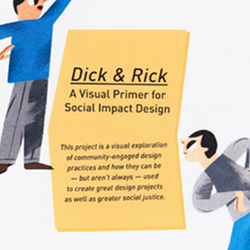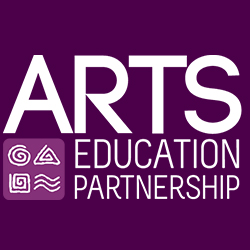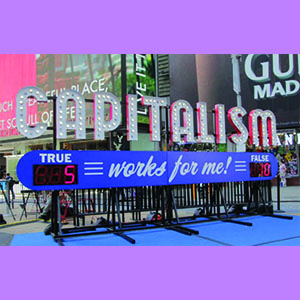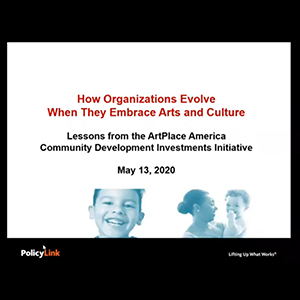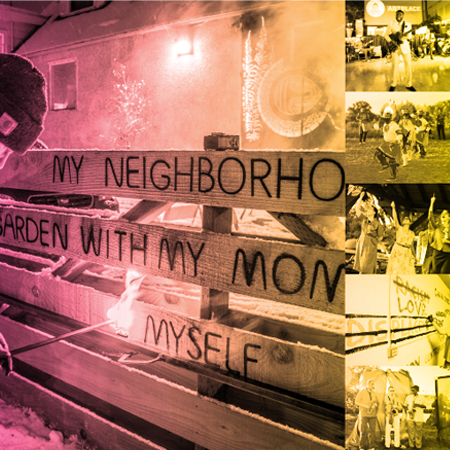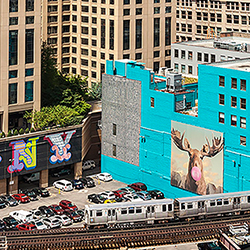DICK & RICK: A VISUAL PRIMER FOR SOCIAL IMPACT DESIGN
More and more people are practicing some form of community-engaged design, or social impact design, or human-centered design. But are there right and wrong ways to do it? The Equity Collective, a group of practitioners in the field, worked with CUP and illustrator Ping Zhu to create a tongue-in-cheek storybook that shines a light on how good community-engaged design practices can not only create good projects, but also advance social justice.
286
DOING WELL AND DOING GOOD BY DOING ART
Are there connections between involvement in arts learning and general academic success? In 2009, this researcher analyzed ten additional years of NELS data related to the previously studied students, then age 26. The results strongly connect arts learning with both general academic success and pro-social outcomes (i.e., outcomes such as volunteerism, involvement in the community, or civic participation).
EXPLORING THE ROLE OF ARTISTS IN CREATING A MORE JUST AND SOCIAL PUBLIC
As a long-time activist and co-founder of the Boston-based Design Studio for Social Intervention (DS4SI), Lori Lobenstine discusses making meaning and creating change in the public sphere through the integration of social justice strategies with art, design thinking, and social practice. Offering several examples from DS4SI’s own work as well as other domestic and international examples, she describes the creation of an energetic, new, third space—one where activists and artists come together with a shared understanding of the powerful possibilities for creative social interventions that can shift “small-c culture” and create change at the scale of the public. The paper applies a theoretical framework to understand how artists’ use of “productive fictions,” “elegant gestures,” humor, and surprise can interrupt social norms, helping people imagine new solutions to complex social problems. In this integrated work, Lobenstine and DS4SI promote “small-d democracy,” in which people can exercise their interest in and ability to impact the parameters of daily life through art and design.
HOW COMMUNITY DEVELOPMENT ORGANIZATIONS CHANGE WHEN THEY EMBRACE ARTS AND CULTURE
This webinar features leaders of community-based organizations and the artists with whom they have partnered to hear the stories and learn the lessons from their local strategies and internal transformation. The webinar is based in the four-year journeys and future plans of the Cook Inlet Housing Authority, a tribal housing agency in Anchorage, the Jackson [Mississippi] Medical Mall Foundation, and the other organizations in ArtPlace America’s Community Development Investments (CDI) initiative. These experiences provide lessons for community development corporations, nonprofit housing developers, health services providers, park associations, and economic development agencies on how this creative work gets designed, carried out, and sustained.
HOW ORGANIZATIONS EVOLVE WHEN THEY EMBRACE ARTS AND CULTURE
This is the second in a series of briefs that describe the changes, insights, and lessons when arts and cultural strategies are deployed in service of comprehensive community development and planning. During ArtPlace America's Community Development Investments initiative, six participating organizations which had not previously focused on the arts developed creative placemaking projects and cultural strategies that could help them more effectively achieve their missions. PolicyLink conducted a research and documentation project to measure the progress, immediate outcomes, and impacts of those projects. This brief examines how these organizations grew and changed internally in order to incorporate arts and culture into their overall direction and day-to-day practices.
INFORMAL ARTS: FINDING COHESION, CAPACITY AND OTHER CULTURAL BENEFITS IN UNEXPECTED PLACES
A team of ethnographers from the Chicago Center for Arts Policy at Columbia College (CCAP) conducted a research study to investigate adult participation in the “informal arts” which encompasses such diverse experiences as acting in community theater, singing in a church choir, writing poetry at the local library, or painting portraits in a home studio. These “hands-on” activities tap people’s creative potential and expand our concept of artistic participation beyond the role of audience member.






